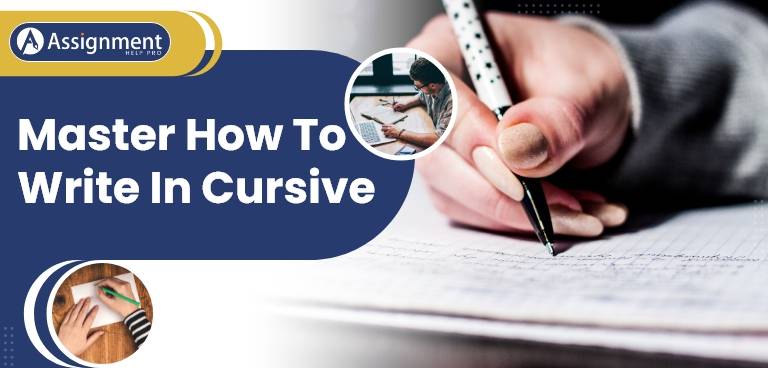Learning a new skill can be exciting, and knowing how to write in cursive is a great one. Cursive writing is a beautiful way to express yourself through handwriting. By practicing the basics of cursive writing, you can write in a flowing and elegant style that adds a personal touch to your notes and letters.
Nowadays, when almost everything is done through digital devices, students of older age suffer from bad and incomprehensible handwriting. Therefore, cursive writing is gaining importance in graduate school. Typing on the screen has made everyone’s handwriting bad, but it is a quick fix for doing many tasks. Hence, students are leaning towards learning how to write in cursive.
In general, cursive writing is more popular among people who want to take up calligraphy as a profession or become a cartoonist. However, the art of writing by joining letters is not as easy as a breeze, as the smooth caress of lines seems to be. You must learn where to begin and end your curves of the syllables. If you want to learn the details of cursive writing, this blog can be of great help to you. From here, you can learn the methods and ground rules and get invaluable tips to develop cursive writing skills.

What is Cursive Writing and Why is it Important?
Cursive writing is a style of penning words. Primarily, students use it to improve their handwriting skills. Here, you curve the structure of the words and link one to another. In block letter handwriting, you lift your hand every time to write a different letter or digit separately. However, in cursive writing, you keep your hand placed on the copy. Hence, it increases your writing speed. You may find cursive writing by another name – script writing, though it is very rarely used.
Learning how to write in cursive has many advantages. Some of the most prominent ones include:
1. Help reduce letter confusion
There are some tricky words in the 26-word English syllable. It includes ‘p’, ‘q’, ‘b’, and ‘d.’ First-time learners can easily write letters backward or face upside-down. The situation is more pronounced for dyslexic students. They make more errors in letter formation. But if they practice joining and writing the syllables, these errors can be reduced.
2. Increase focus on writing
The cursive format for lettering the syllables makes the writing run in a flow, and therefore, creative expressions come out in fluidity and without any hesitation. Moreover, reducing the number of times to lift the pen helps in maintaining concentration on the task.
3. Enhance the speed of writing
The other reason why teachers encourage students to write in cursive format is to increase the speed of penmanship. The same features that increase the concentration of writing are also responsible for increasing the speed. To restate, it is the connection of the letters. Hence, a student will bring the pen up from the paper only to write a different word. Hence, they can write more at a given point in time.
What are the Ground Rules of Cursive Writing?
Cursive writing might be just a simple writing style that you use for your everyday writing. However, if you look at it from the point of view of a calligrapher, it is no less than an art. Hence, in your day-to-day use, you must maintain some basic rules if you have any of the three objectives:
- You want to learn how to write in cursive accurately to make your script pleasing to your eyes
- Pursue cursive writing as a hobby
- Learn the basic steps of becoming a calligrapher.
Here are the basic rules of cursive writing:
- Make all letters of the entire content the same height.
- Begin writing all small letters from the top.
- Keep your ovals and parallel lines accurate.
- Maintain equal lengths for block letters in cursive writing as well.
- Make the downstrokes of parallel letters parallel to each other
How to write in cursive
To write letters in cursive format, you must follow these 5 simple steps.
- Begin your writing with a Cursive Alphabet
- Learn to write Lowercase Letters in Cursive
- Set Your Hand At The Uppercase Cursive
- Selecting a Cursive Font
- Practice Regularly
How to Begin Your Writing with a Cursive Alphabet
Famous American author Mark Twain once said, “The secret of making progress is to get started.” However, starting at a unit level and then moving to its combinations makes the learning more profound and the foundation stronger. Therefore, before you begin you start learning to write words in cursive, you must begin with an alphabet.
What are the Tricks to Write Lowercase Letters in Cursive?
Once you know how to write the alphabet in cursive form, begin to write words starting with lowercase. It will help you get a grip on the words in upper and sentence cases. Moreover, when you start to write the cursive letters in lowercase, begin your task with the word ‘u’. It is the easiest of all 26 alphabets. Then, move on to other simple vowels and consonants like b, f, h, I, j, k, l, m, n, p, r, s, t, u, w, x, y
The use of just one stroke to form the words makes these words easy to write. Additionally, most lowercase letters stay inside the top and bottom lines. While some of them stop as they hit the bottom line, others go to the right and end their formation. Therefore, forming words with these letters becomes quite easy.
Once you have mastered writing words beginning with ‘u’, then go on to write words with ‘o’ in the lower case.
After that, move on to the letters b, f, and k.
These letters are more complex than ‘u’ and ‘o’. However, you can still complete them in one single stroke, but their shape is quite complicated. Once you feel comfortable writing them, you can then easily learn the formation of the curved syllables c, d, and e. Once you are done with forming words in lower case with this cursive letter, you can easily form the more complex letters.
Where to Begin Writing the Uppercase Cursive?
Once you have a grasp of writing words in lower case, only then put your hands on the uppercase letters. First, work on the capital letter L. It is just the work of a single stroke.
Then move to learn C, E, G, L, and O. After you are done working on the ovals, put your hands on the syllable ‘R’, the hardest of all letters to write.
However, after mastering this letter, you can easily form B, D, F, I, J, P, and T. These syllables will require much less effort to form in cursive format.
How to Select a Cursive Font
The fourth step involves choosing the right font. Some students and professionals choose a single font and use it for cursive writing throughout their entire lifetime. However, others like to master their hand at different cursive writing fonts.
If you want to know how to write in a cursive font and are confused about selecting a font that will help you develop your style, open Microsoft Word or Google Docs and drop down the list of font styles. Then, carefully study the fonts and choose one that you would like to work on. Here are some of the most popular styles.
- Allura
- Aguafina Script Pro
- Blackjack
- Caballero
- Columbine Light
- Kuenstler Script
- Fancier Script
- Lavender Script
- Shelley Script
- Citadel Script
- Buffet Script
- Hummingbird
- Creamy Script
- Ragazza Script
- Ritts Cursive
- Belinda
- Style Script
- Bendo Script
- Brody
What is the Need for Practicing Cursive Writing Regularly?
You must have heard of the proverb ‘Practice makes a man perfect’ or ‘use it, else you lose it.” These terms apply to mastering the art of cursive writing as well. Unlike learning to ride a bicycle, your cursive writing skills rust if you don’t practice them daily. Hence, you must dedicate some time and energy to it.
If you cannot devote long hours to this task, commit just 20 minutes to it. First, start with a few paragraphs, then move to a page, and finally complete a manuscript. If you get bored developing your cursive writing in one style, keep your eyes open while you read a card, newspaper, or wall graffiti on the road, and you will find inspiration and new styles everywhere.
After a while, you can craft cursive from your brain and have your personalized cursive styles. It will help you to master the strokes quickly and with perfection.
Read more: What is Descriptive Writing and How to Write a Descriptive Essay?
Foolproof Tips to Create Manuscripts in Cursive Styles
Here are some tips to write in cursive fonts:
- Never forget to start with lowercase letters when you first learn how to write in cursive.
- Buy cursive writing sheets or download them. Replicate or trace the letters.
- After you master writing cursive letters in lowercase, try copying or tracing capital letters.
- Neatly join the letters.
- Take time to select the font for cursive writing and focus on it. It will help you understand the specific way of making cursive strokes.
- Practice cursive writing for no less than 20 minutes each day.
- Get your grips on the simple syllables ‘𝒪’ or ‘𝒰’ as you start your cursive writing as a beginner. It includes making just a single stroke of a pen. Then step onto writing the complex letters.
- Do not overwrite a letter or write it too quickly. It will not serve the purpose of learning it. Instead, take your time to create beautifully curved pieces. Don’t overdo it.
- Don’t hold your pen too hard or put high pressure on the paper while you write in the cursive format. This is one of the most common mistakes students make while writing a paper, and it costs them the speed of their writing. The best idea is to hold your paper loosely and let the writing flow.
- Practice exercises on hand movement. It will make your hands flexible and enhance your skill in cursive writing.
- In this digital era, many people prefer to write on iPads and similar devices. However, still, there is no substitute for pen or pencil and paper. It makes your writing more personal and helps you learn the strokes in more detail.
- When you want to learn how to write in cursive as a beginner, it is best to start your cursive writing on lined paper. Although plain white paper also works. You can align your words precisely. Moreover, ruled papers also help in learning and enhancing skills in all writing formats.
- Stash all cursive writing practice sheets in a separate file or binder. You can learn easily, and it will help you to arrange all the resources and work methodically.
Conclusion
Learning how to write in cursive is an invaluable skill. Apart from noting your day-to-day tasks, it is helpful to live through rare, significant issues. For example, when you suffer from a system failure, but have to develop your academic papers. But it should not be an issue for you anymore, now that you have read the details of scripting highly impressive cursive writing. Get our assignment help if you struggle with cursive writing. The experts from our team will suggest valuable tips and help you improve your cursive writing skills.




